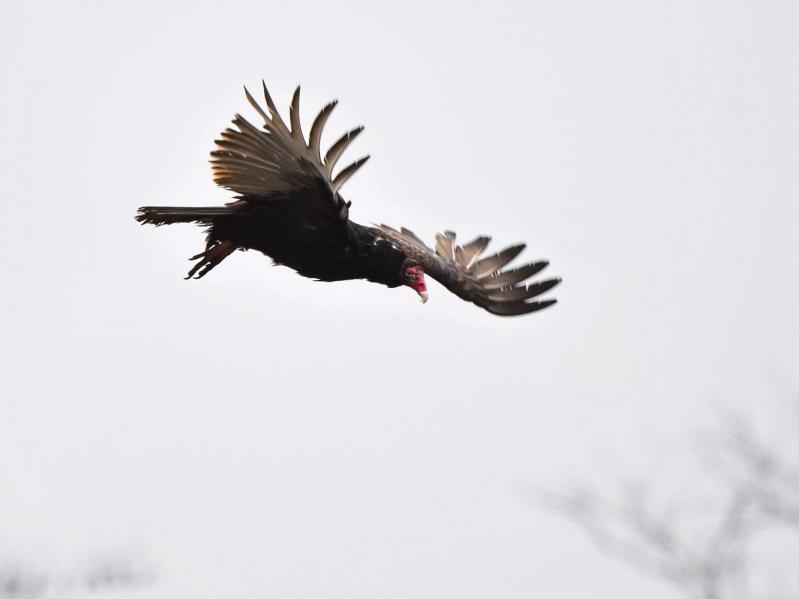If given the opportunity, a turkey vulture would eat you, your kids, and your little dog, too. Other bird species may be struggling, and humans are flailing about in chaos, but the turkey vulture is doing just fine eating dead things. Look up, if you dare, and watch as they trace black circles in the sky above, patiently waiting to alight and delight in a meal. Yes, with increasing signs that the end is nigh, the turkey vulture is a strong candidate for Bird of 2024.
Too dark? Well, it doesn’t get better the more you learn about this charismatic bird.
“I have this trap for crows,” said Kevin McGowan, a senior extension associate at the Cornell Lab of Ornithology. “It’s a room-sized cage that has a ladder in the top. Birds drop in but can’t get out. Once we caught a vulture. I sent an instructor in to get it out. The vulture responded by puking on him.” An interesting defense mechanism. Can you imagine what regurgitated roadkill must smell like?
They have worse habits. Allaboutbirds.org reports that if they get too hot, they intentionally poop on their feet, you know, to cool off.
“They’re weird,” said Mr. McGowan. “They love dumps. Old food. They’re regular visitors to the Cornell compost facility. The biggest draw is always the uneaten food from the dorms.”
They also have a sense of irony. They’re slightly larger than an osprey and often misidentified as bald eagles, which most describe as “majestic,” and aren’t bald at all, while the turkey vulture has a wart-filled bald red head. But before you start with the bald jokes, understand it’s functionally bald. When it leans in for a choice cut of carrion it doesn’t want its feathers all covered in gore.
Other than its red head, it’s largely black: faded black. From below, its wings appear two toned: black on the shoulders and wrist, and gray on the flight feathers. More irony? This hideous bird is one of our most elegant in flight, and one of my favorites to watch. They hold their wings in a “V” shape that ornithologists call a “dihedral.” They teeter and totter around the sky as if attempting to balance on some invisible tightrope. Eagles have a completely different flight style. “Eagles look like a flying door,” said Mr. McGowan.
Even though they appear unbalanced, Mr. McGowan says their flight style is incredibly stable. The stability gives them the opportunity to move low and slow, allowing their powerful sense of smell to detect decaying meat. (They’re not picky, they eat dead fish too.) Countless times I’ve seen the sun eclipsed by a low vulture and have been startled at how large they appear.
While walking last weekend in Sag Harbor, I passed a house with nine lined on its roof ridge, apparently waiting for some unfortunate soul to step outside and die so they could feed. It didn’t happen that way. When I passed the house shortly after, the vultures had departed. What was happening? They were probably just waking up from roosting (they’re communal roosters) and had moved from a nearby evergreen tree to warm up in the early sun.
A couple of years back, Sabina Streeter, a resident of Sag Harbor Village, had 15 or so roosting near her house. “They were incredibly stoic and undisturbed,” she said. “I had a feeling they might move onto my porch. They couldn’t care less about me or the dog.” But that’s only because Ms. Streeter and her dog were alive. Turkey vultures never attack living prey.
Oddly, Riverhead is a hotspot for turkey vultures. Go to jury duty and you’ll see dozens of them lined up on the windows of the courthouse, unaware that New York doesn’t have a death penalty. At the nearby Roanoke Avenue Elementary School, turkey vultures crowd around the chimney, presumably enjoying the fumes.
“Big time vulture migration is going on right now,” said Mr. McGowan, which is why you might notice this bird more in the coming days. A hawkwatch in western New York counted 1,000 last week. While 50 years ago turkey vultures were rare on Long Island, they can now be found year round. “The population of turkey vultures has been increasing since the 1960s. A straight line with a constant increase,” Mr. McGowan said. Maybe they’re increasing because they’re hard to kill. Eating all that dead stuff has given them incredible immune systems.
They even like their trees dead. They wait for them to fall and then use them as nests.
They have some gnarly habits, but if they weren’t around, you could expect the world to smell a lot worse. They do the dirtiest of all jobs and in so doing, reduce the spread of disease.
I’ve had some fun here at the expense of the turkey vulture but consider the following written by R.I. Brasher, a human, in “Birds of America” in 1905. “We amused ourselves by catching some of these ungainly birds with a lasso laid on the ground and encircling some bait. A number fought to escape; others simulated death, remaining in an apparently unconscious condition for ten minutes at a stretch. We decorated them with paper collars and cuffs and a few bits of ribbon, then released them and they flew aloft like aerial mountebanks.”
Maybe, as a human, I’ve no right to judge the ways of the turkey vulture after all. We have our issues too.

